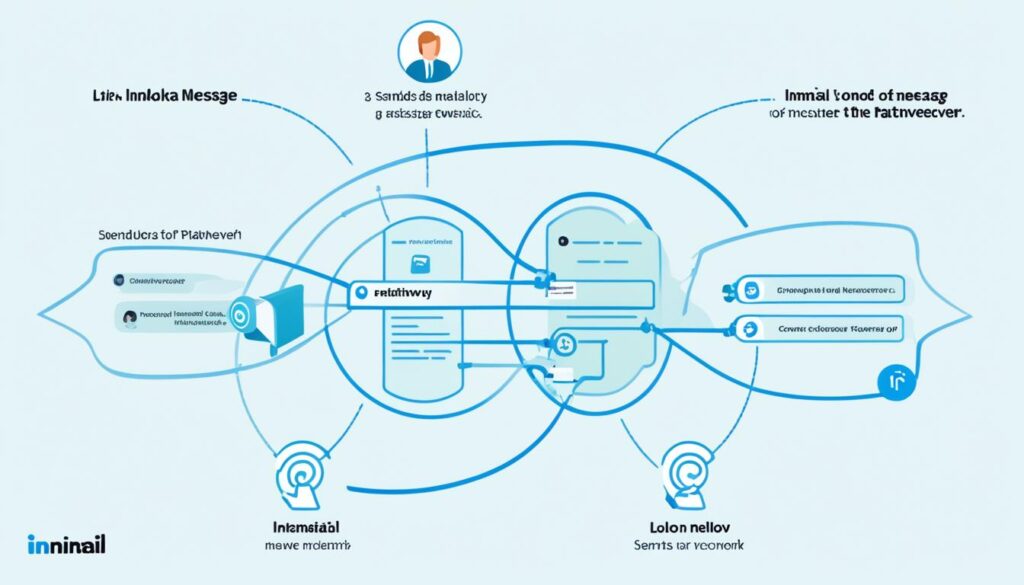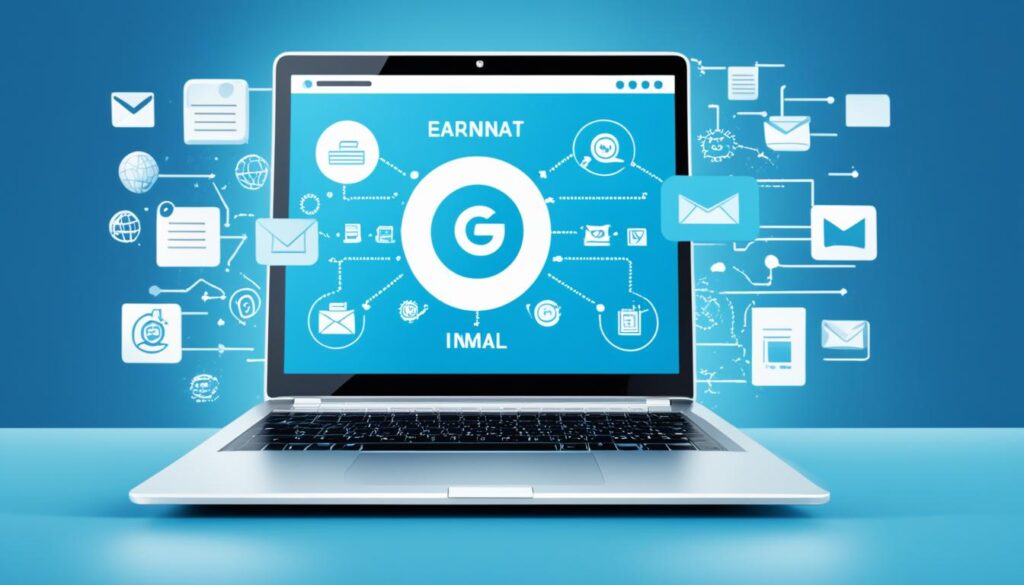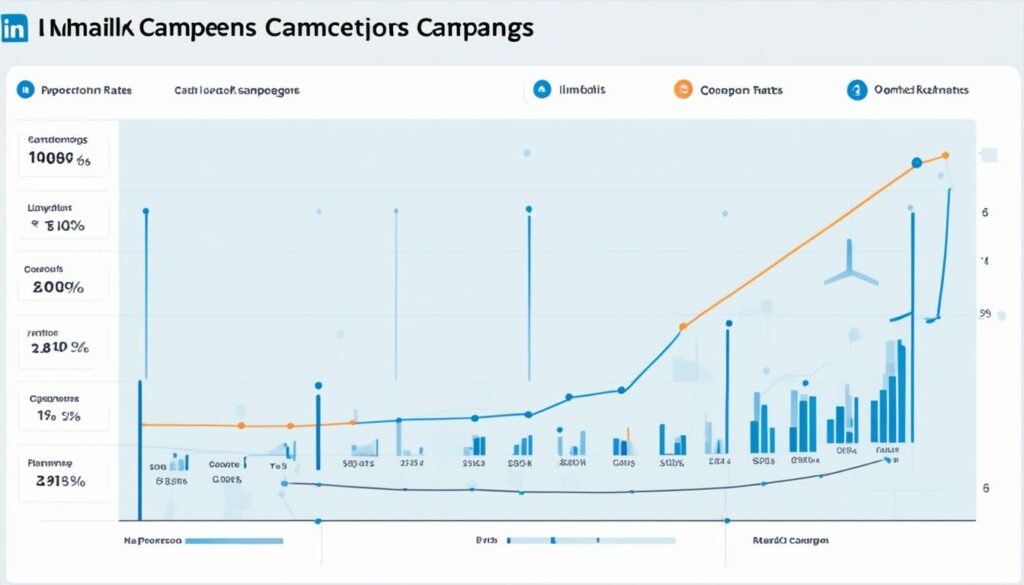Want to connect with people on LinkedIn who you’re not friends with yet? LinkedIn InMail is a great way to do this. It’s a powerful tool. But are you getting the most out of it? Check if you’re using it fully
This guide will teach you to make the best use of LinkedIn InMail. You’ll learn how to grow your professional connections and spot new chances. We’ll show you how to write messages that work and how to see if they’re doing well.
Key Takeaways
- LinkedIn InMail is a paid feature that allows you to message any member, even without a connection.
- InMail messages are 2.6 times more effective than email or phone calls in generating responses.
- Personalized InMail outreach can outperform bulk messaging by 15%.
- Crafting a compelling subject line and message is crucial for InMail success.
- Tracking and analyzing your InMail campaigns can help you refine your strategies for better results.
Introduction
LinkedIn InMail lets you connect with any member directly, even if you’re not friends. It’s a special feature for reaching out to new business partners, clients, and leaders. With InMail, you can boost your career by making meaningful contacts and finding new opportunities.
What is LinkedIn InMail?
LinkedIn InMail is like sending an email to anyone on LinkedIn, whether you know them or not. Unlike regular messages, you can talk to people not in your network. This makes it great for networking and reaching out to new contacts. Learn more here.
Benefits of Using InMail for Networking
LinkedIn InMail offers many advantages for networking:
- Send messages to important people outside your network
- Messages go straight to the inbox, increasing response chances
- Connect with industry leaders or potential partners for new chances
- Demonstrate your skills and make a strong first impression
- Improve your profile and be more visible on LinkedIn
Overview of the Guide
This guide will explain everything about LinkedIn InMail. You will learn how to use it well and how to measure your success. It’s perfect for building new connections, finding leads, and growing your network.
Understanding LinkedIn InMail
LinkedIn has two ways to connect privately. You can send a regular message or an InMail. InMail lets you message someone on LinkedIn, even if you’re not friends. But, you need a Premium account for this, which costs money.
How InMail Works
To send an InMail, go to someone’s profile and click “Message.” You can also find a member and send them a message. There are three kinds of InMails: Paid, Free, and Sponsored. How many you can send depends on your LinkedIn plan.
Differences Between InMail and Regular Messaging
With InMail, you can message anyone on LinkedIn, not just your friends. This is great for making new contacts or finding clients. But, you have to pay for InMail. Regular messages are free for everyone.
Who Can Use InMail?
If you have a Premium account, you can send InMails. This also includes Sales Navigator and LinkedIn Recruiter users. You can send free InMails too, but only if the person allows it. Sponsored InMails are for ads and marked as “Sponsored.”
| LinkedIn Subscription Plan | Monthly InMail Credits | Maximum Accumulation |
|---|---|---|
| LinkedIn Premium Career | 5 InMail credits | 15 InMail credits |
| LinkedIn Premium Business | 15 InMail credits | 45 InMail credits |
| LinkedIn Sales Navigator | 50 InMail credits | 150 InMail credits |
| LinkedIn Recruiter | 150 InMail credits | 450 InMail credits |
It’s important to know how LinkedIn InMail works. You need to understand the differences between InMail and regular messages. Knowing who can use InMail is also key to using this tool well.

Setting Up Your LinkedIn Profile for InMail Success
To be successful with InMail, having a top-notch LinkedIn profile is key. First, use important words in your headline, summary, and job info. This optimization will draw in folks looking for your expertise.
Optimizing Your Profile for Visibility
Put the right words all over your profile to be more findable on LinkedIn. Include terms, titles, and skills that show what you do. This way, people looking for someone like you can easily connect.
Highlighting Your Skills and Experience
Show off your skills and work history on LinkedIn. Talk about what you’ve achieved and any honors you’ve won. This shows why others should reach out to you.
Adding a Professional Profile Picture and Headline
Don’t forget a good profile picture and a catchy headline. They make a great first impression and might get you more InMail replies.
“LinkedIn InMail acceptance rates can increase by 40% when using personalized messages.”
When your LinkedIn profile shines, using InMail will be more effective. Take time to make a profile that shows who you are and what you can do well. This will help you meet your networking and career aims.
| Key Statistic | Insight |
|---|---|
| 80% of people on LinkedIn have the ability to drive business decisions | Optimizing your LinkedIn profile is crucial for reaching decision-makers and expanding your professional network. |
| Top sellers on LinkedIn close 51% more deals than their peers | Leveraging InMail can significantly boost your sales success by connecting with the right prospects. |
| Over 75% of people who recently changed jobs used LinkedIn to inform their career decision | Maintaining a strong LinkedIn presence can help you stay visible to potential employers and industry peers. |
Crafting Effective InMail Messages
The secret to great InMail is writing messages that are interesting and tailored. For recruiters online, InMail messages are key for first connecting with candidates. Making a strong impression is very important.
Writing a Compelling Subject Line
Begin by writing a subject line that catches the reader’s eye. LinkedIn advises using 25 to 40 characters in your subject line. Titles such as “Thanks,” “Connect,” and “Job opportunities” work well.
Personalizing Your Message
Personalize your message to the recipient’s interests or experiences. Sending a personalized message greatly increases your chances of success. It really makes a big difference.
Being Clear and Concise
Keep your message clear, short, and to the point. Avoid using complex language or too many details. Organizing your message with a clear introduction, interesting point, and what you offer is best for more responses.
Including a Call to Action
End with a strong call to action. Ask the recipient to connect or discuss opportunities. A good call to action can push the candidate to reply.
By using these methods for subject lines, personalizing messages, and making them clear with a good call to action, you can write InMail that gets noticed. This way, you can better connect with your desired candidates.

Best Practices for Using LinkedIn InMail
To make your LinkedIn InMail messages work better, there are key steps to take. Research your recipients first. Choose when you send your messages wisely. Finally, remember to follow up properly. Doing these things well can make your outreach more successful. It will help you get better responses and make stronger connections.
Researching Your Recipient
Start by learning about your recipient before you write them. Find out about their career, what they like, and their goals. Knowing this will let you write a message that matters to them. It shows you really want to connect. Use their LinkedIn profile to get the info you need.
Timing Your Messages Appropriately
Choosing the right time to send your InMail matters a lot. LinkedIn says messages sent between Sunday and Thursday do best. It’s better than sending them on a Friday or Saturday. Also, keeping your messages short helps. In fact, messages of 400 characters or fewer get more replies. By being concise and choosing the right days, you’ll do better with your outreach.
Following Up Professionally
Following up is just as important as sending the first message. Using LinkedIn’s Automated Follow-Ups can really help recruiters. They see more people accepting InMails this way. When you follow up, keep it respectful and clear. Be helpful without being too pushy. Aim to build a real connection. Show you’re interested in helping them reach their work goals.
“Three in four hiring professionals (74%) hope that generative AI can automate repetitive tasks to prioritize more strategic work.”
Following these best practices can enhance your LinkedIn InMail game. Remember the key points: know your recipients well, pick the right time for messages, and follow up correctly. It’s quality, not quantity, that makes InMail outreach effective.
Measuring the Success of Your InMail Campaigns
It’s very important to check how well your LinkedIn InMail campaigns are doing. You should look at things like open and response rates to see if your messages are working. Think about what your messages say, their titles, and when you send them. Then, you can use this information to make your InMail outreach even better.
Tracking Open and Response Rates
Look at how many people open and reply to your InMails. Short InMails get answered more than long ones. And messages made just for someone do better than those sent to lots of people.
Analyzing Message Effectiveness
Dive into what your InMails say and when you send them. If LinkedIn marks a person as a “Recommended Match” or they say they’re “Open to Work,” they will probably answer more. Most replies come in fast, with many in the first 24 hours. Mondays are the best days to send messages.
Adjusting Strategies Based on Insights
Now, use what you learned to make your InMail plans better. Sending messages just to one person works better than sending them to many. Picking “Recommended Matches” and people “Open to Work” can up your chances. Keep checking and fixing your plan to make sure it works well.

“Tracking open and response rates, analyzing message effectiveness, and adjusting strategies based on insights are crucial for maximizing the success of your LinkedIn InMail campaigns.”
Case Studies: Successful InMail Outreach
We will look at real cases showing how LinkedIn InMail can work. Through these stories, you’ll see how people in different jobs used this tool. They built strong business ties, found good leads, and grew their networks.
Case Study 1: Building Business Relationships
Sarah, a manager in tech, sent a LinkedIn message to a big influencer, Amanda. She talked about their tech backgrounds and her interest in working together. Amanda liked this and they met for a virtual coffee. This led to a great partnership for Sarah’s company.
Case Study 2: Generating Leads
Alex used LinkedIn InMail to find and connect with possible customers for his marketing tool. He studied his prospects well and crafted powerful messages. This got him many good leads. One lead, a marketing manager at a growing company, became a big customer for Alex.
Case Study 3: Expanding Professional Networks
After college, Sarah used LinkedIn InMail to grow her network. She sent messages to top people in her desired industry. Her notes talked about her skills and excitement for the work. This approach helped her get job offers from top firms.
These studies show how LinkedIn InMail can help with many work goals. It is great for making strong business connections, finding good leads, and growing networks. This can lead to big success in different fields.
Refine your LinkedIn InMail outreach,explore inspiring InMail examples, andlearn the best LinkedIn outreach strategiesto maximize the impact of your InMail campaigns.

Conclusion
In the end, LinkedIn InMail stands out for helping with networking, leads, and career moves. This guide shows how to make effective messages and connect with key people. It also covers how to track your progress.
Recap of Key Points
We looked into why LinkedIn InMail is better than cold emails, needing a personal touch and aiming at the right time. Make sure your LinkedIn page is top-notch. Craft sharp subject lines and messages. Always improve, looking at your data.
Encouragement to Start Using InMail
Have you started using LinkedIn InMail yet? It’s a great way to grow your network, find new clients or partners, and look into job openings. With a good strategy and by keeping things personal, InMail can really boost your career.
Final Tips for Effective InMail Outreach
Keep your InMail messages short, personal, and sent at the right time. Use the best practices from this guide. This includes working on your profile and researching your contacts. Be professional when following up. Try using InMail templates and experimenting to see what meets your needs and those of your audience.
FAQ
What is LinkedIn InMail?
What are the benefits of using InMail for networking?
How does InMail work?
What’s the difference between InMail and regular LinkedIn messaging?
Who can use LinkedIn InMail?
How can I optimize my LinkedIn profile for InMail success?
What are the best practices for crafting effective InMail messages?
How can I measure the success of my InMail campaigns?
Source Links
- InMail LinkedIn : comment ça marche et best practices
- Inmail VS Connection Request: What Get More Replies? [2024]
- How to Introduce Yourself to a Stranger on LinkedIn
- How to Request Introductions with InMail
- How to Write a LinkedIn Introduction Message That’s Friendly and Professional
- How to get a LinkedIn connection to introduce you to someone
- What Are LinkedIn InMail Messages & How Do They Work? [2024]
- How I Decide When To Use LinkedIn InMail
- What is LinkedIn InMail? The Complete Guide [2024] | Skylead
- This is the secret to a successful LinkedIn InMail
- 10 LinkedIn InMail Best Practices | LinkedIn
- A complete guide to LinkedIn InMail
- Crafting Effective LinkedIn InMail Messages
- How do you craft a personalized and compelling InMail message?
- The 5 Best Ways To Get 8x More InMail Responses
- You’ve Got Mail: 6 LinkedIn InMail Best Practices You Should Know
- 6 Best Practices for Using LinkedIn Recruiter’s AI-Assisted Messages
- 5 LinkedIn InMail Best Practices (Infographic) – brafton %
- How to Improve Your InMail Response Rate, According to LinkedIn Data
- Compare your Linkedin InMail campaign – Digivizer
- A Comprehensive Guide to LinkedIn InMail in 2024
- How LinkedIn InMail Can Refine Candidate Outreach Strategies
- 4 LinkedIn InMail Templates for Sales and Networking Success | Gong
- Best LinkedIn Outreach Messages Strategy (+10 Templates)
- Linkedin Inmail Best Practices: 11+ Tips To Get More Replies
- 10 Best LinkedIn InMail Templates and Best Practices
- 12 LinkedIn InMail Best Practices: Writing InMail Messages – Octopus CRM